After an almost perfect group stage for France, except for their defeat against Tunisia, being one of the teams that played the best, or was probably the best team in terms of performance on the field, it was time for Didier Deschamps’ team to play against Poland led by Czesław Michniewicz, who showed little or nothing in the first phase of the World Cup with a team that was tactically off and not very solid in its ideas, as well as being very flat in the different phases of the game.
With a magnificent performance by Kylian Mbappé, France enjoyed their third victory in the tournament, which booked their ticket to the quarterfinals where they will face England in a game that will be extremely rich in the tactical part. However, first, we are going to analyse how and what things were key for France to beat Poland 3-1 with two goals from Mbappé and one from Olivier Giroud.
In this tactical analysis, we dive into the tactics of both teams in the form of analysis and see how Didier Deschamps’ France qualified for the quarter-finals of the World Cup.
Lineups
France went on to the field with their traditional 4-2-3-1 with Hugo Lloris, Jules Koundé, Raphael Varane, Dayot Upamecano and Théo Hernández; Adrién Rabiot, Aurélien Tchouaméni, Antoine Griezmann, Ousmane Démbéle, Kylian Mbappé and Olivier Giroud.
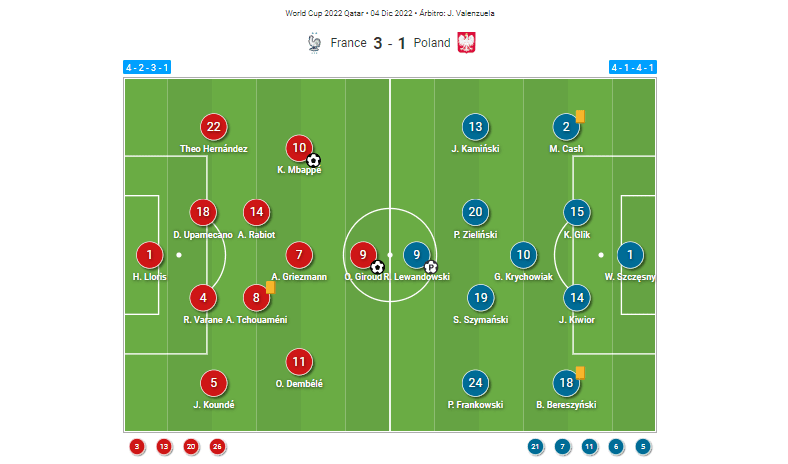
Poland set up a 4-5-1 with Wojciech Szczesny on goal, Bartosz Bereszynski, Jakub Kiwior, Kamil Glik and Matty Cash in defence; Grzegorz Krychowiak, Piotr Zielinski and Sebastian Szymanski in midfield; Przemyslaw Frankowski, Jakub Kaminski and Robert Lewandowski in attack.
Griezmann’s role and midfield movements
In the preview, France was clearly superior in terms of quality in difference to the Polish team, which tactically never looked so solid inside their ideas and never had a fun or strong system through their lines and options to choose for the starting eleven, which had a Robert Lewandowski in his most likely last World Cup of his career, where he was -at least- able to score his first two goals in the tournament.
With the fluidity that Didier Deschamps’ team had shown, it was more than obvious what was expected within the tactical aspects of this match: A team that was going to dominate possession like France and another in the vast majority of the game, closing the spaces with a block low enough and locking the mid lane so that players like Antoine Griezmann did not appear there, who was one of the best players of the match as he managed to beat Poland’s block consecutively.
One of the first things, already seen during the competition, were the movements of Antoine Griezmann, who beyond starting positionally as a #10, was and it is the French footballer with the most freedom of movement on the field under Deschamps. He normally seeks to drop from his zone, which is near Giroud, to support in the base of the play along with Rabiot and Tchouameni, thus accelerating processes in congested areas, which with his quality, can be and has been key in small spaces to make his team progress quickly and be threatening.
Poland constantly sought to defend themselves in a 4-5-1 formation that accumulated many people on the inside lanes, but Griezmann’s creativity and technical quality in each of his receptions added a lot so that France could progress through the centre and through the lines, with different positions and heights, but with the same idea: Receive and accelerate, to break the block and create chaos within it. Given the passivity that Poland looked to generate, Griezmann gave a lot of speed with his executions and decisions.
These touches from Griezmann at lower heights of the pitch, acting as a #8 more than a #10, were pure master class. As soon as the central defenders or some close teammate found the passing option clean enough to pass the ball to him, he already knew what he was going to do in the next 2-3 seconds when he took the ball. He normally looked to control the ball or to execute first-time passes as well to the outside or into half-spaces.
What we are seeing below is what Griemznan was looking for from the first moments of the game and he gave France too much. The first-time passes to the outside that Théo Hernández or Kylian Mbappé could receive, which when Griezmann received inside, attracted markings and gave him it gave these two more time to think about what to do with their decisions, usually making vital penetrating carries for their nation.
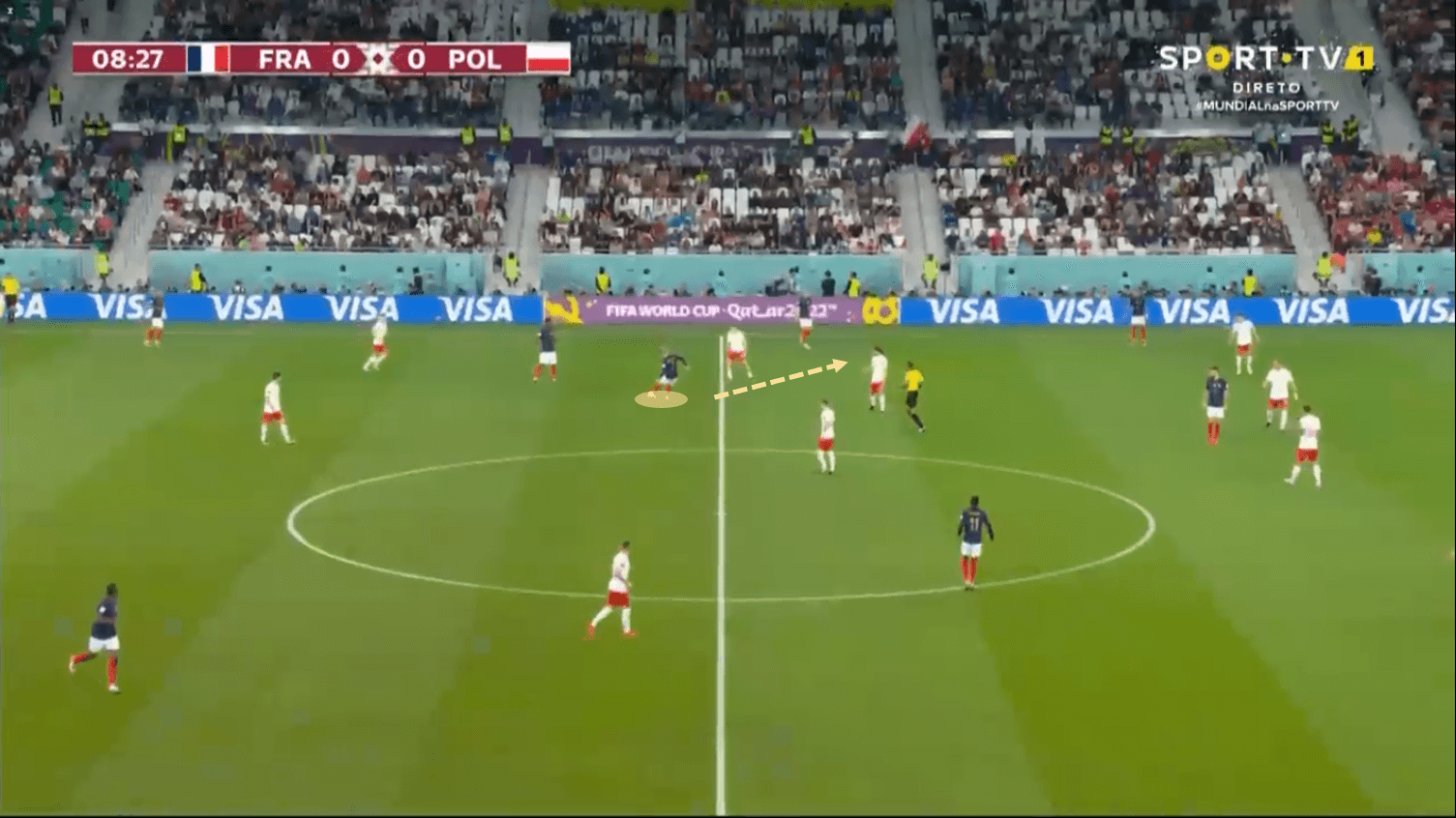
In the build-up, the forward movements were also key to helping Griezmann when he wanted to break the rival block. As in their previous matches, France sought, in most cases, Kylian Mbappé to play in half-space, and Théo pinning wide. Thus, Griezmann could find Mbappé who was immediately looking to play with Théo, to generate extremely dangerous 2v1 situations.
With the mental and technical agility of a player like the ex-Barcelona player, he made high-quality passes so that his team could get through the most difficult part of making plays, which is the midfield, especially when he has so many people and they are charging the central channel so much. With him, France found it very easy to progress from behind with low touches without forcing the long ball.
In this example, we see what we have mentioned already. Mbappé took the half-space and Griezmann, which received from Adrien Rabiot, executed a first-time pass in the half-turn looking for a teammate in said area. A marvellous through-pass.
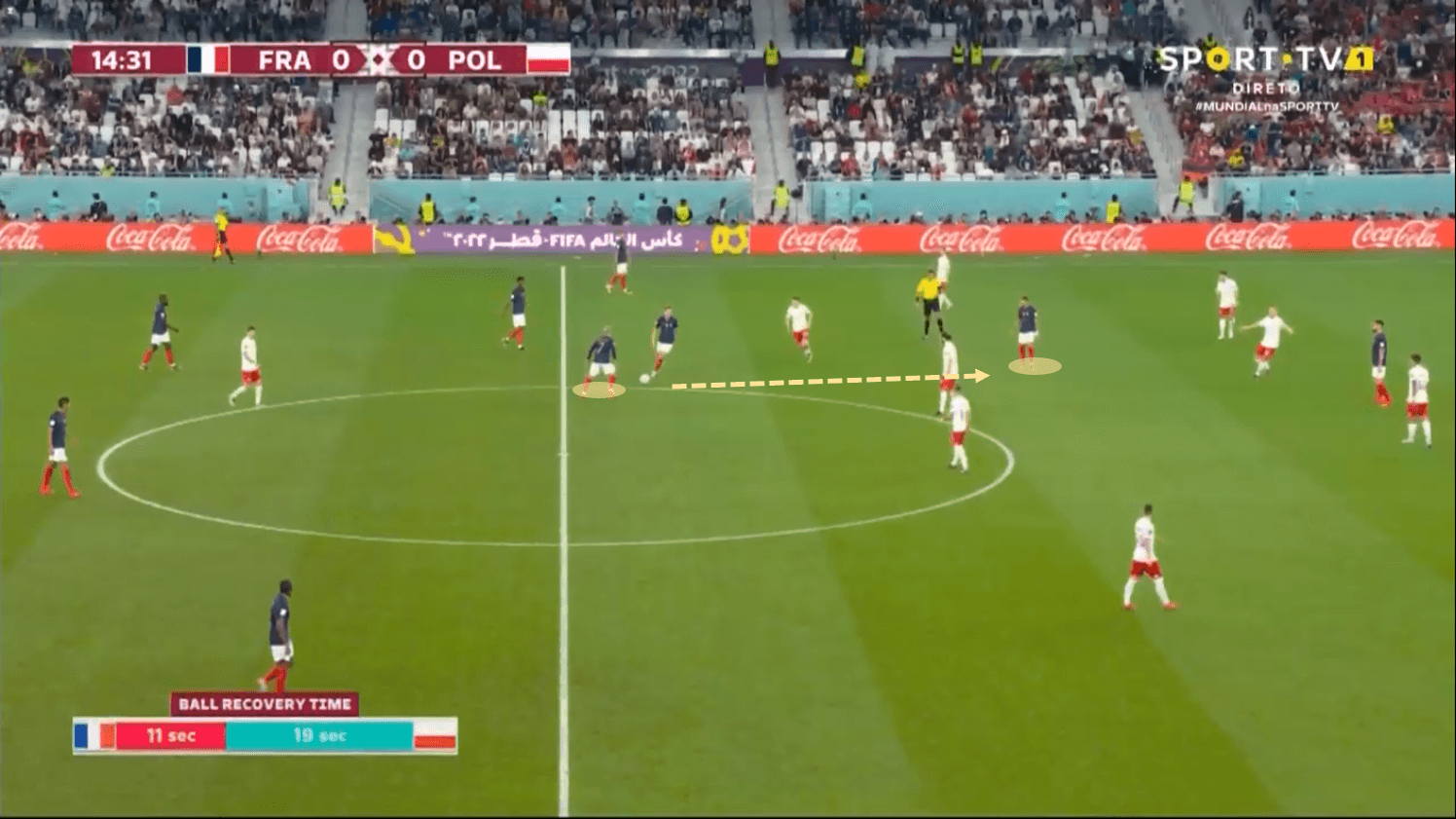
But Griezmann’s ideas and creativity went beyond what many players in Poland expected him to be able to do in the face of what they think it was, rigid lines, which were unbalanced within the first minutes of the match, the more they passed, the more fragile they became noticeable.
When receiving in higher areas of the field, the Atlético de Madrid player sought to carry out through-passes so that either Kylian Mbappé or Olivier Giroud could perform runs, diagonals or attacking space, in order to score one-on-one against the goalkeeper. One of these passes was executed in the 14th minute of the match, where Giroud was in charge of carrying out the run behind, and Mbappé of making the decoy run to attract the marking of one centre-back and create spaces. Movements were coordinated and were well improvised by a creative mind like ‘Grizou’.
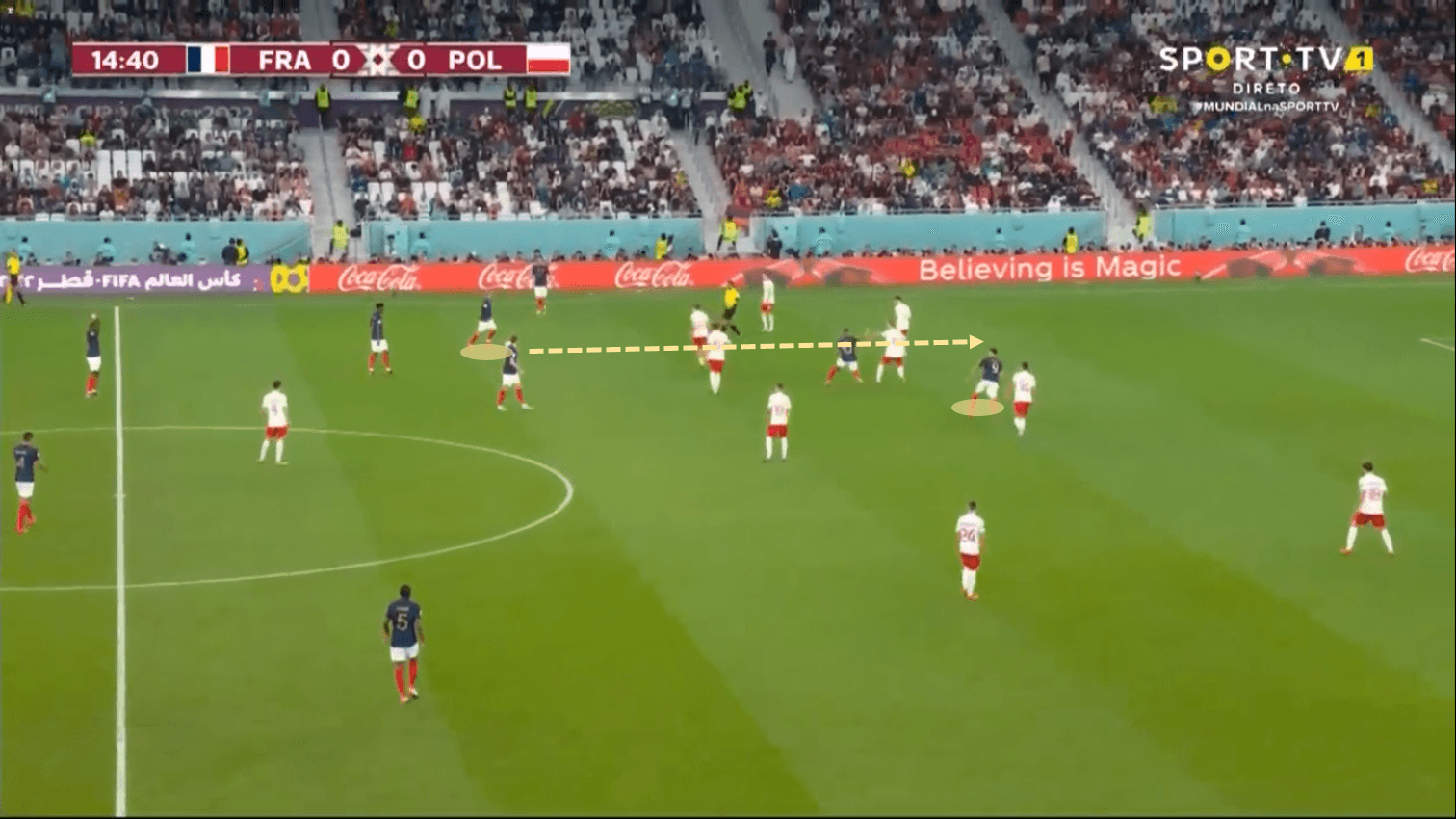
These passes were also made in the attacking third, which were even more threatening because they arrived and penetrated the rival penalty box to find Giroud so that he could finish these passes closer and closer to Szczesny’s goal.
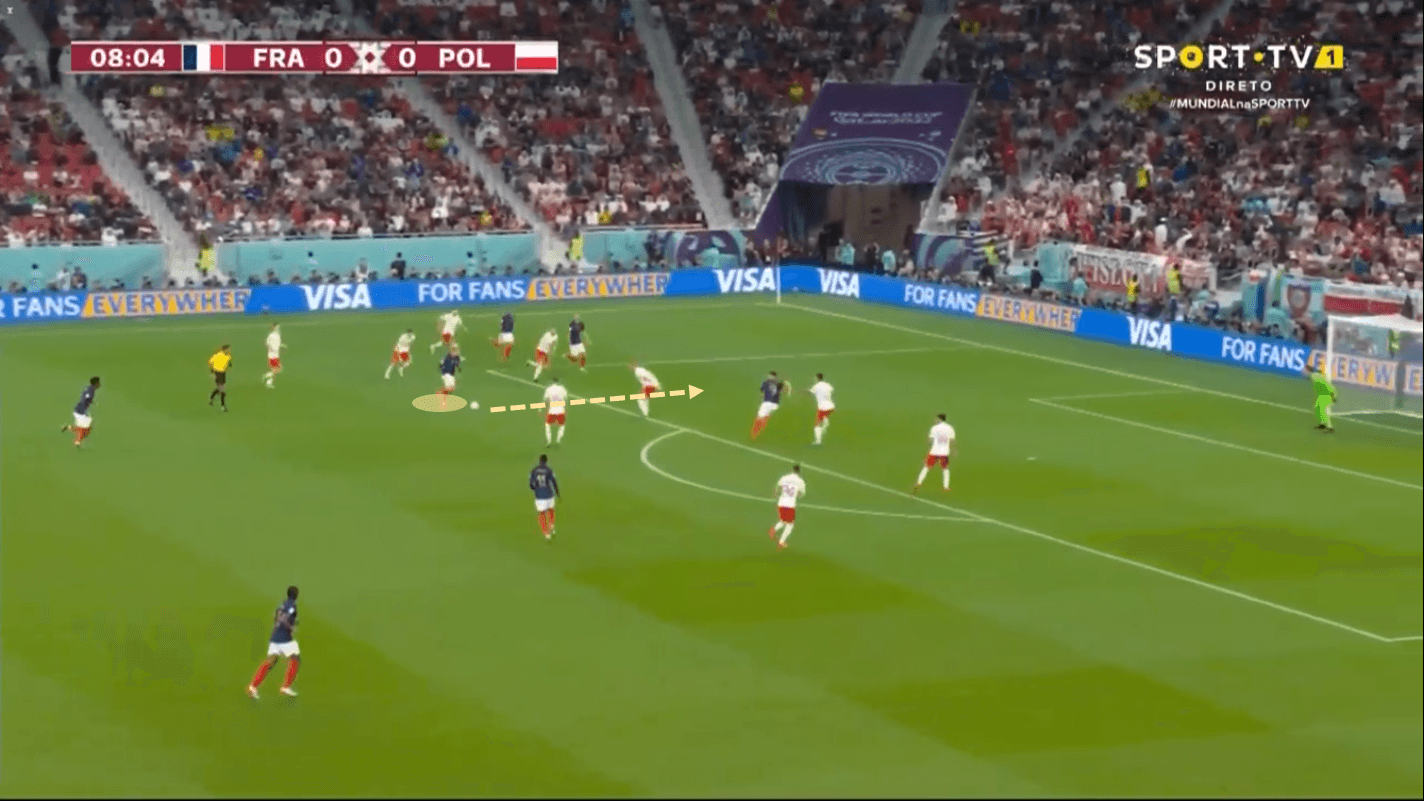
Despite France’s constant dominance on the ball, they had to adjust a few things before making it 1-0 as Poland were making them pass the ball from side to side for about 10 minutes, where Deschamps’ men found no answers against the low block.
Thus, Aurélien Tchouméni took a rather interesting role in possession, looking to stretch the opponent, moving outward taking the outside lane, so that Kylian Mbappé would stay in the half-space, but this would make Poland move their lines there and separate more their lines, which was going to make them progress to the French who were looking to change to the weak-side of the ball if this was done, or inside with some reception from Mbappé. In addition, this made Adrien Rabiot take another height, attracting the full-back and consequently freeing Théo on the outside.
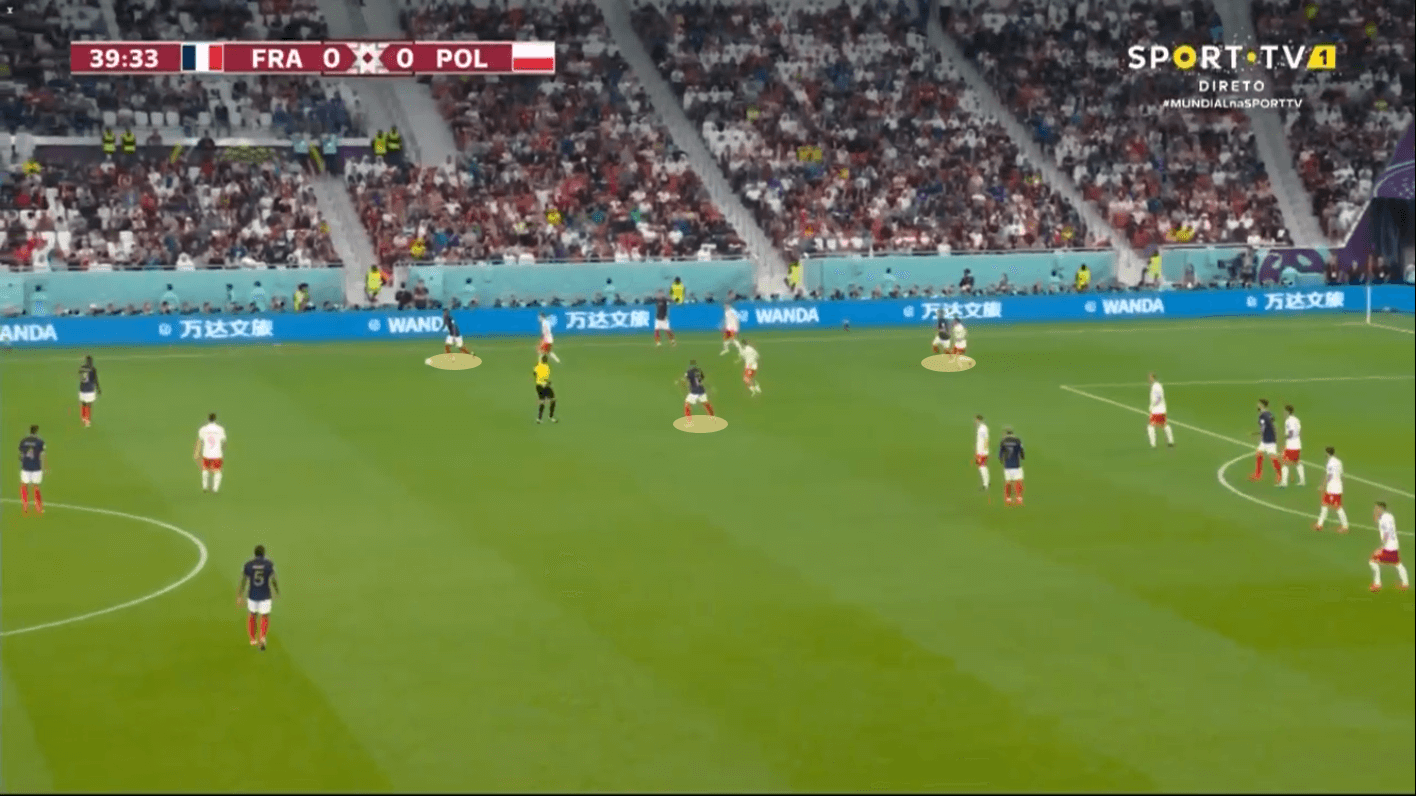
Mbappé-Théo movements and the high-pressing from France
Kylian Mbappé was absolutely the key for France in this match, in terms of contributing goals for his team, which is already normal for him. With his speed and change of pace, he was unstoppable for Matty Cash by his wing who had a duel that seemed endless with every touch of the ball from the PSG player. However, his movements inside him were also extremely important, many times exchanging the channel with Théo, with whom he has shown great synergy and tactical understanding.
Griezmann took the reins of the game, controlling the tempo and the speed at which it was played. That’s why he would approach each flank of the field if the ball was played wide, so he could receive the ball and then turn completely to the weak side of the ball. That was the idea of France looking to break the block of Poland, the speed with which they changed sides and only players as dangerous as Démbéle or Mbappé always appeared on the outside.
It was important in order to look for Kylian who, in this example, is receiving, as many times in the match, a ball played that was previously completely changed the side, also as a first-time type of pass, by Griezmann. These are the first signs of what was expected from France in most of his progressions, Mbappé was very wide on his left wing, looking to dribble outside and show his explosiveness with his speed that is unstoppable for any defender in the world.
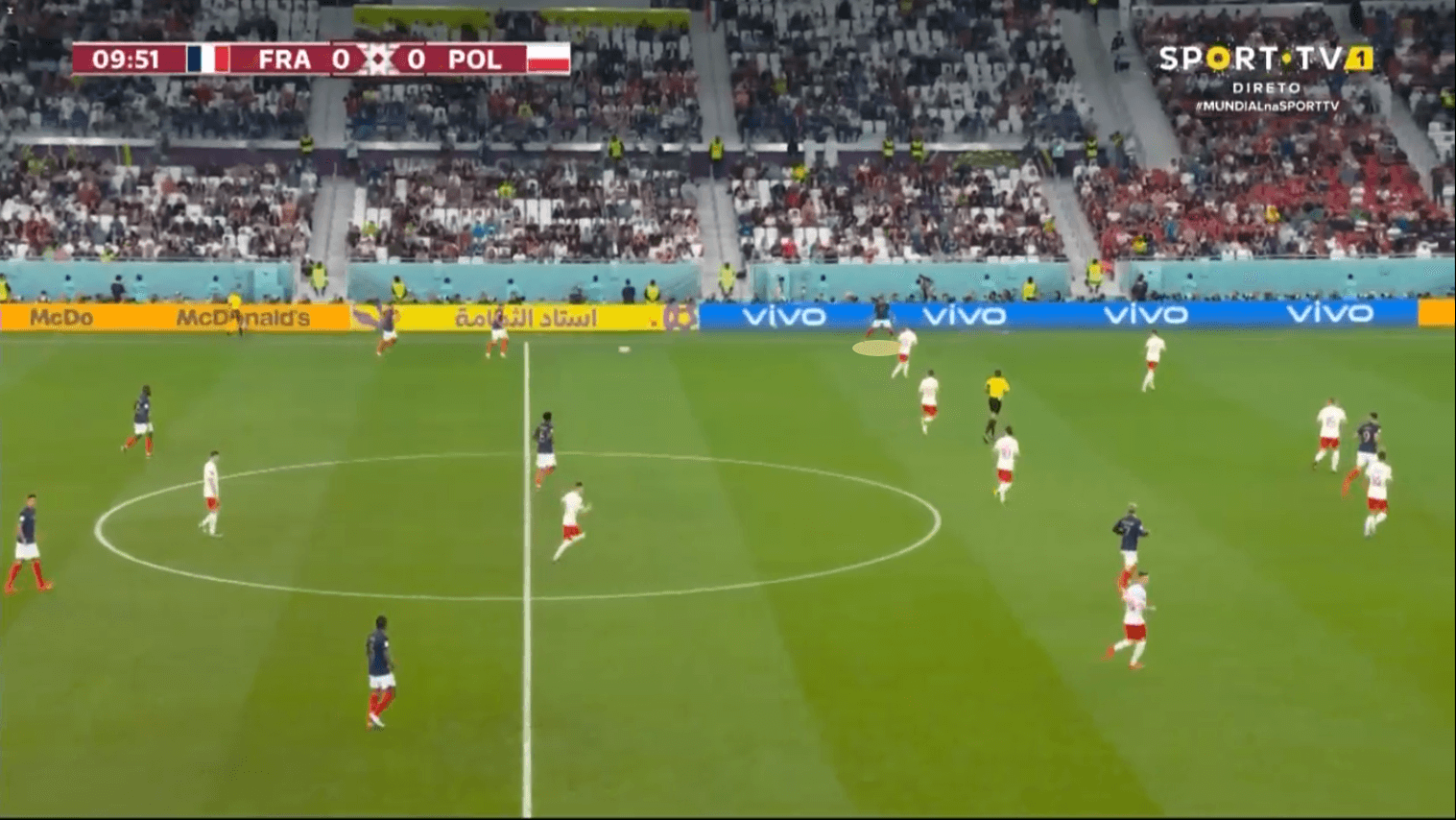
But, as in their match against Denmark and Australia, where they had an extremely positive fluidity on the ball, Mbappé also took half-space on many occasions, which raised doubts for many players attentive to him. Since at any moment he could receive from the outside and the decision to mark or tackle him was very difficult to make. This is why Deschamps, knowing the gravity of his player every time he moves and touches the ball, grants him these tactical exchanges with Théo.
The simple act of occupying these areas between the lines, and then moving or vice versa, is already enough for Mbappé to break the block of any team, but in this case the Poland one. One of the central defenders jumped aggressively to put pressure on him, or the full-back, Cash couldn’t decide whether to go for Théo or for him and in these actions, spaces were generated for each one of them, Théo or Mbappé, to receive and run.
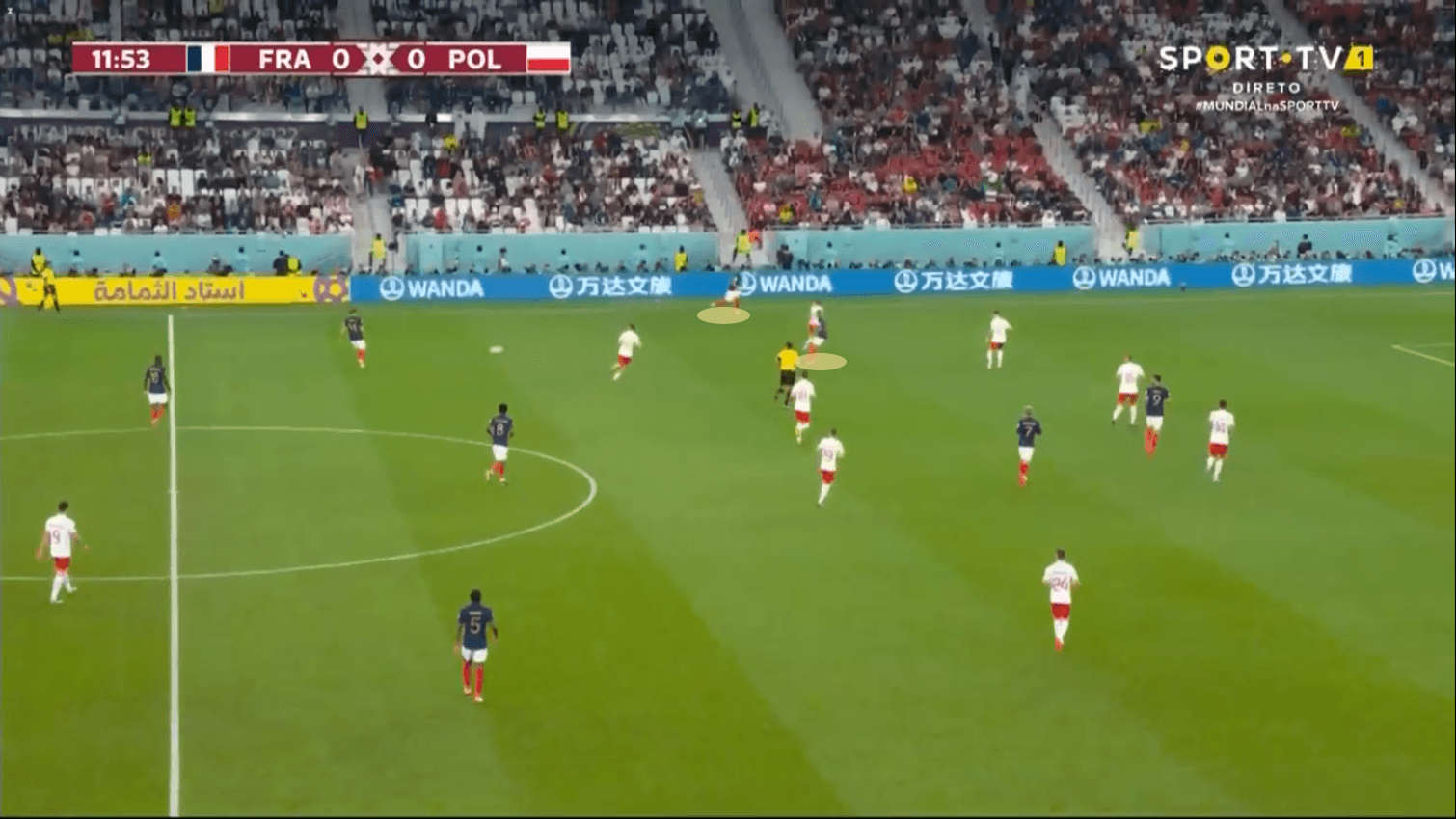
Here is another example, in which Théo Hernández was more like an inverted full-back, leaving the entire lane free for Kylian Mbappé. This rotation was simply a headache for the Polish side, who did not understand when to cover his teammates because this could end up messing up their block so much that they preferred to go 1v1 against Mbappé or Théo, the player who received wide. At the same time, it was a really risky decision since they are two highly technically superior players who could dribble past them.
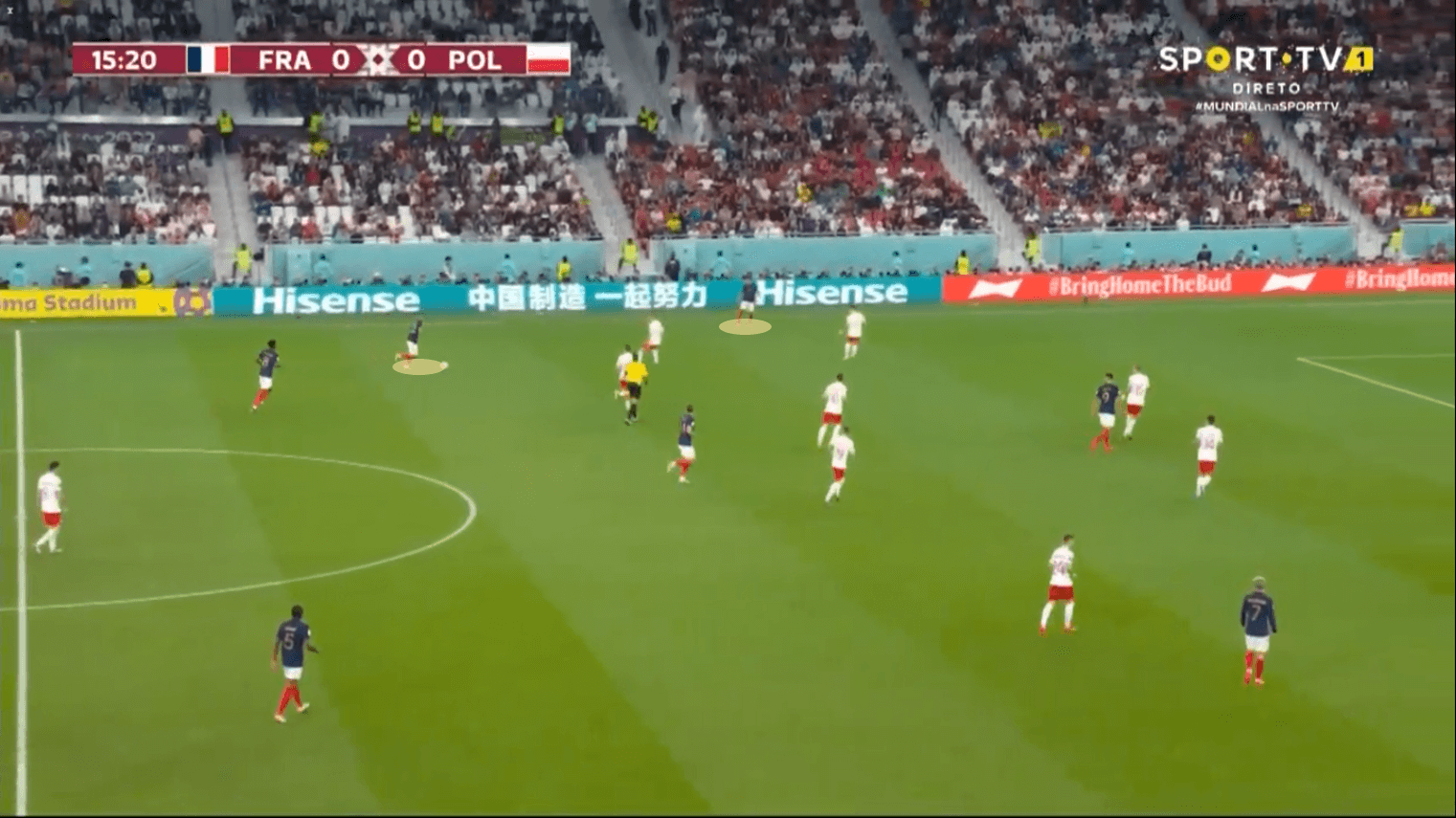
The first goal, scored by Olivier Giroud in the 44th minute of the game, almost at the end of the first half, was previously prepared thanks to these rotations, which also included the participation of Adrien Rabiot in a position that had been seen against Australia to let this kind of situation happen.
The Juventus player always stayed close and ahead of Mbappé, thus performing decoy runs, but in this case, he pinned one of the midfielders who could go into coverage, thus leaving the passing line very clear and alone for Upamecano to connect with Mbappé, who had the help of Théo on the outside, which caused confusion in Cash as to whether to go for him or stay rigid with Kylian. To all this was added the jump of a centre-back, who suffered the pass behind Giroud’s back which ended in a great way 1-0.
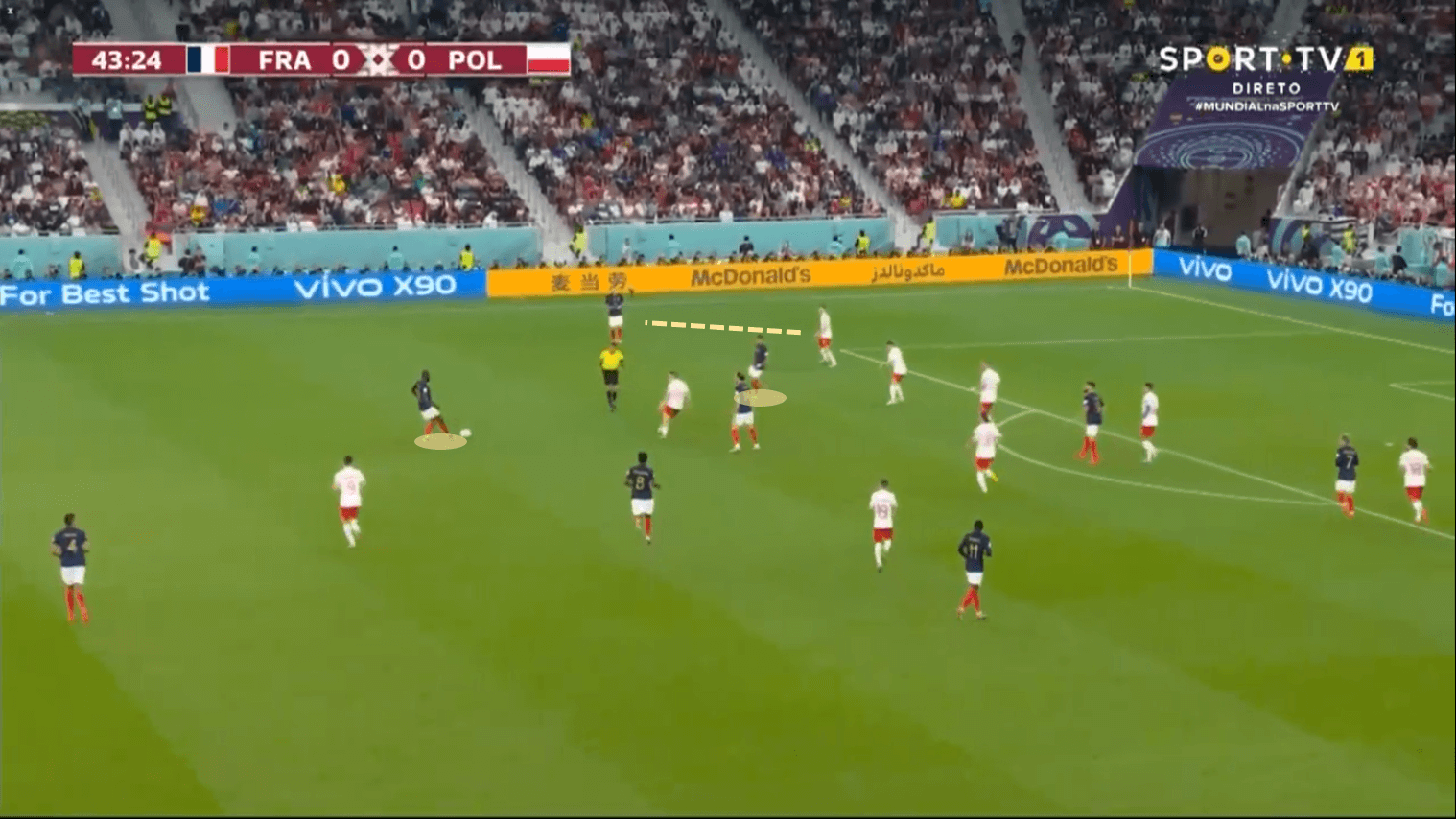
Defensively, France were much more aggressive and defended higher up the field than they had been doing in their previous matches. Rather than waiting for his rival in a mid-block without going to pressure any of the receivers of the first pass or without going to the defenders/goalkeeper, this time it was the opposite and Didier Deschamps wanted to complicate the build-up of the Polish team, which showed deficiencies in this.
The overtaking of the block was clear, and players like Tchouaméni, Griezmann or Rabiot showed an excellent job of pressing high enough to force the error in the first passes of the rival team’s construction.
As can be seen in the picture below, Aurélien Tchouaméni and Adrien Rabiot on the other side, the two most defensive midfielders, in this case, are the ones closest to a possible receiver, while the three in front, close to the ball, Griezmann, Giroud and Dembéle leave some space to then go very tight to mark them if the ball was played for them. The Milan striker did the job of stifling that pass, while the others covered all the options.
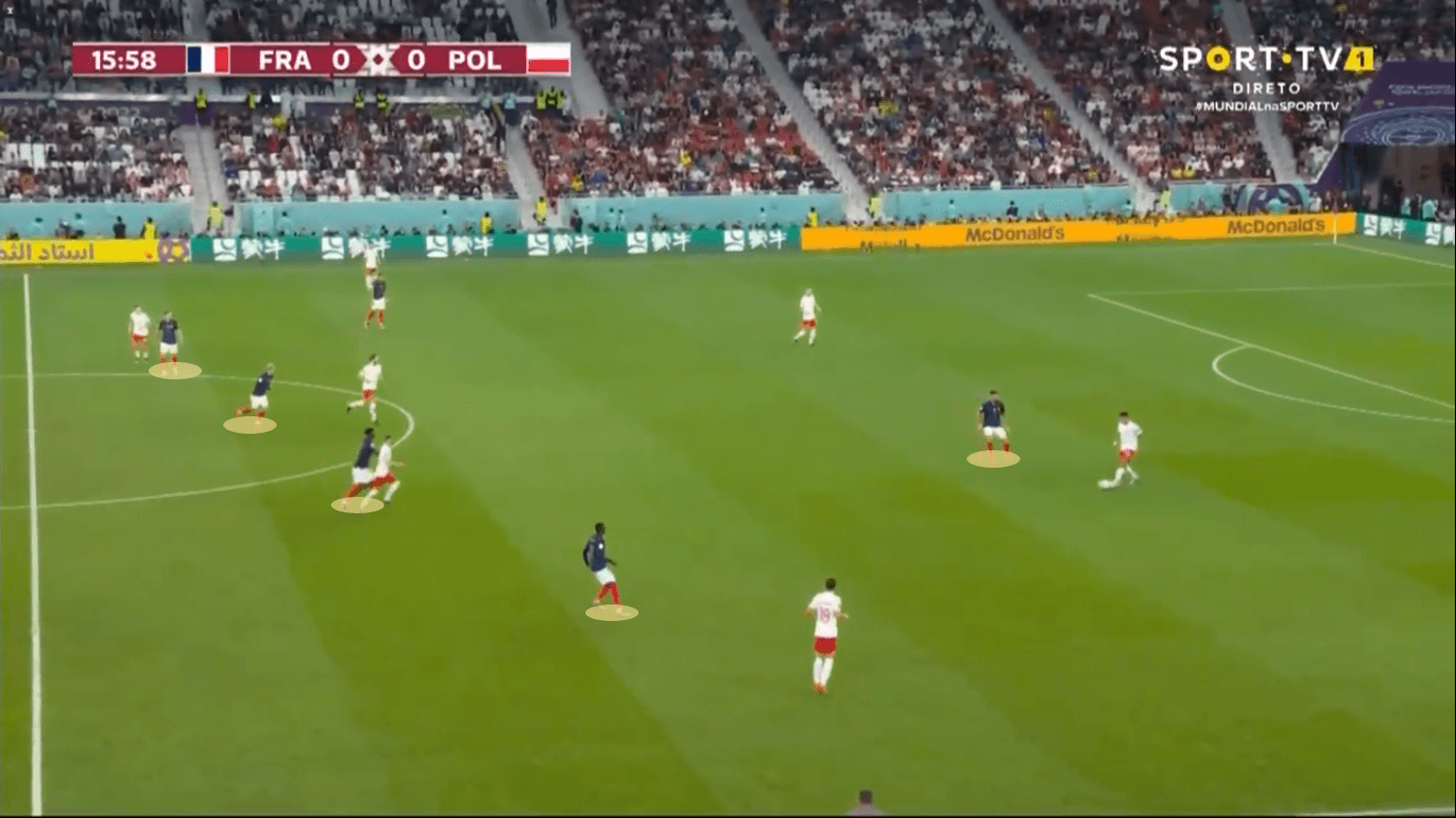
One of the most intense pressing players and positive in the defensive phase, as well as contributing in the offensive one, was Antoine Griezmann, who had the task of pressing Szczesny very closely and intensely when he received a back-pass from one of his teammates, as we can see in the picture presented below.
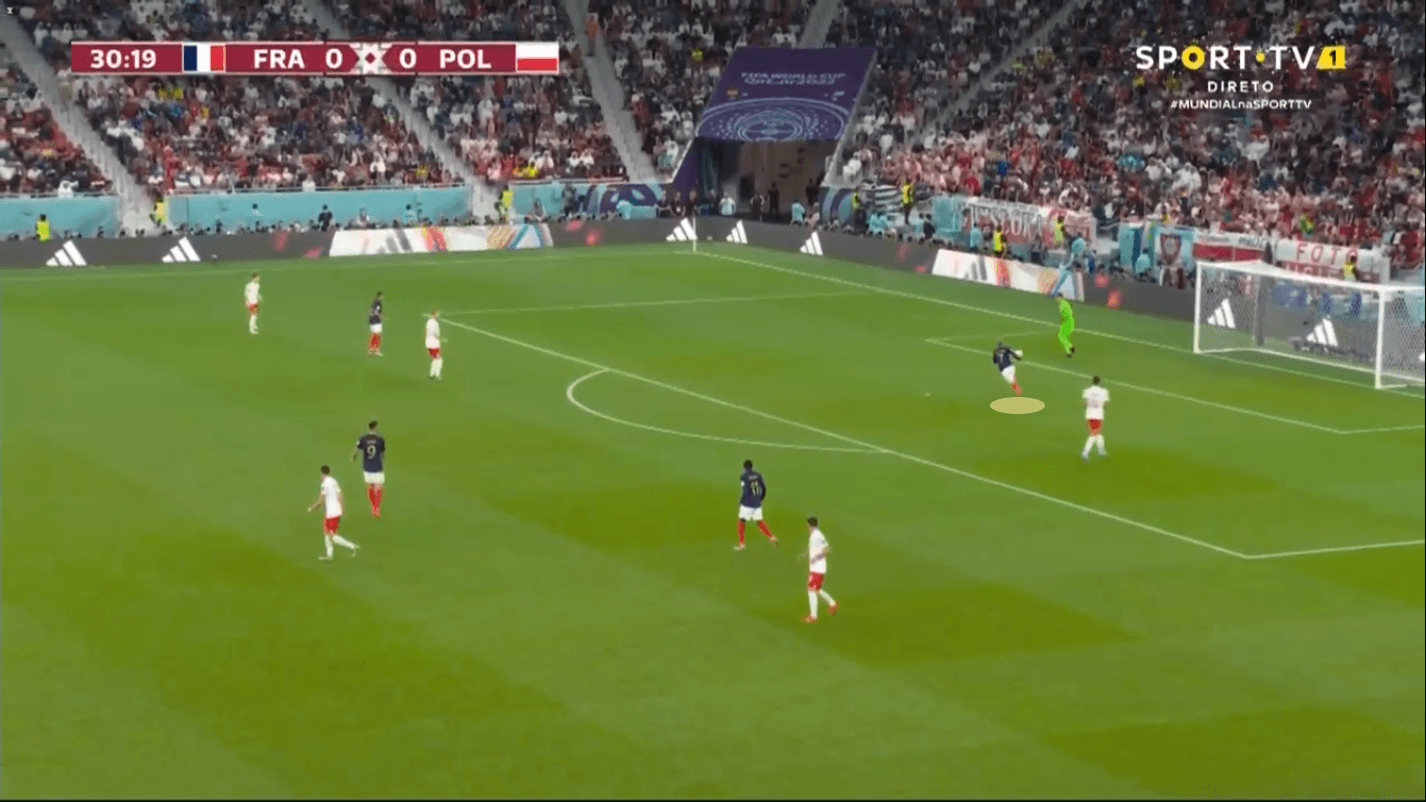
When it was time to retract the lines and sit further back if the rival forced them to start their progression and construction, Dembele joined Rabiot and Tchouameni as a midfielder, who was the one who was most centralized. Up front, Griezmann took the middle, while Mbappé and Giroud joined the very narrow lines on the sides.
The intensity of France to aggressively mark and defend the balls that the Polish side were trying to progress through the lines, was extremely at another mental and physical pace in which Poland wanted to play the game and it was exhausting and stressing them not to see the ball for more two or three passes in a row.
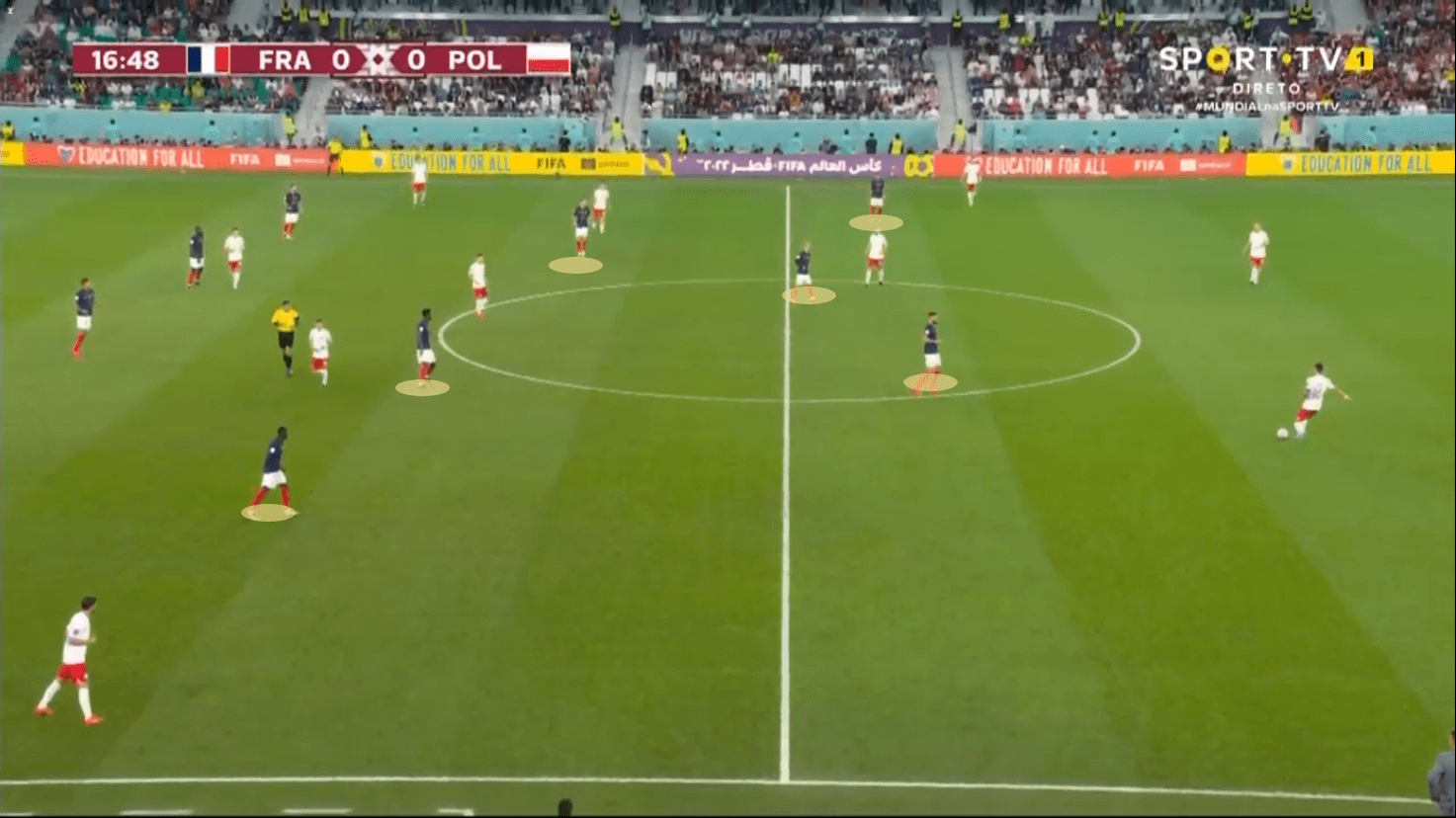
France also counted on the attacking output of players like Olivier Giroud as a target-man, which did brilliantly inside his role and job, but as well Ousmane Démbéle being a wide winger who connects great and constantly with Giroud in these direct types of executions where the Barcelona player run behind him, who was dropping to receive the ball and then execute through-passes.
Conclusion
A tough quarterfinal awaits France, against Gareth Southgate’s England, who once again demonstrated hierarchy and a good level to dominate the matches, as Deschamps’ team has done since the first moment of this 2022 World Cup, with various interesting tactical variants seen on the pitch, and with players so qualitatively superior to the others they have played against.






Comments